E-commerce and Omni-channel Transformation: Research Proposal
VerifiedAdded on 2023/01/18
|13
|2812
|91
Report
AI Summary
This research proposal investigates the impact of e-commerce on consumer behavior and the transformation of retail through omni-channel strategies. The study explores the evolving role of technology in the retail industry, analyzing how e-commerce shapes consumer behavior and the implications of omni-channel transformation. It examines the research questions related to the influence of e-commerce on consumer behavior, the implications of retail omni-channel transformation, and how consumer behavior challenges traditional retailing. The research methodology includes an interpretivist research philosophy, an analytical approach to research design, and a combination of primary and secondary data collection methods. Qualitative data will be gathered through interviews with e-commerce retail managers, supported by analysis of peer-reviewed journals and books. The data analysis will involve a thematic approach, with ethical considerations and limitations of the study addressed to ensure a comprehensive and rigorous investigation. The proposal aims to contribute to the understanding of consumer behavior in the context of e-commerce and omni-channel retail.
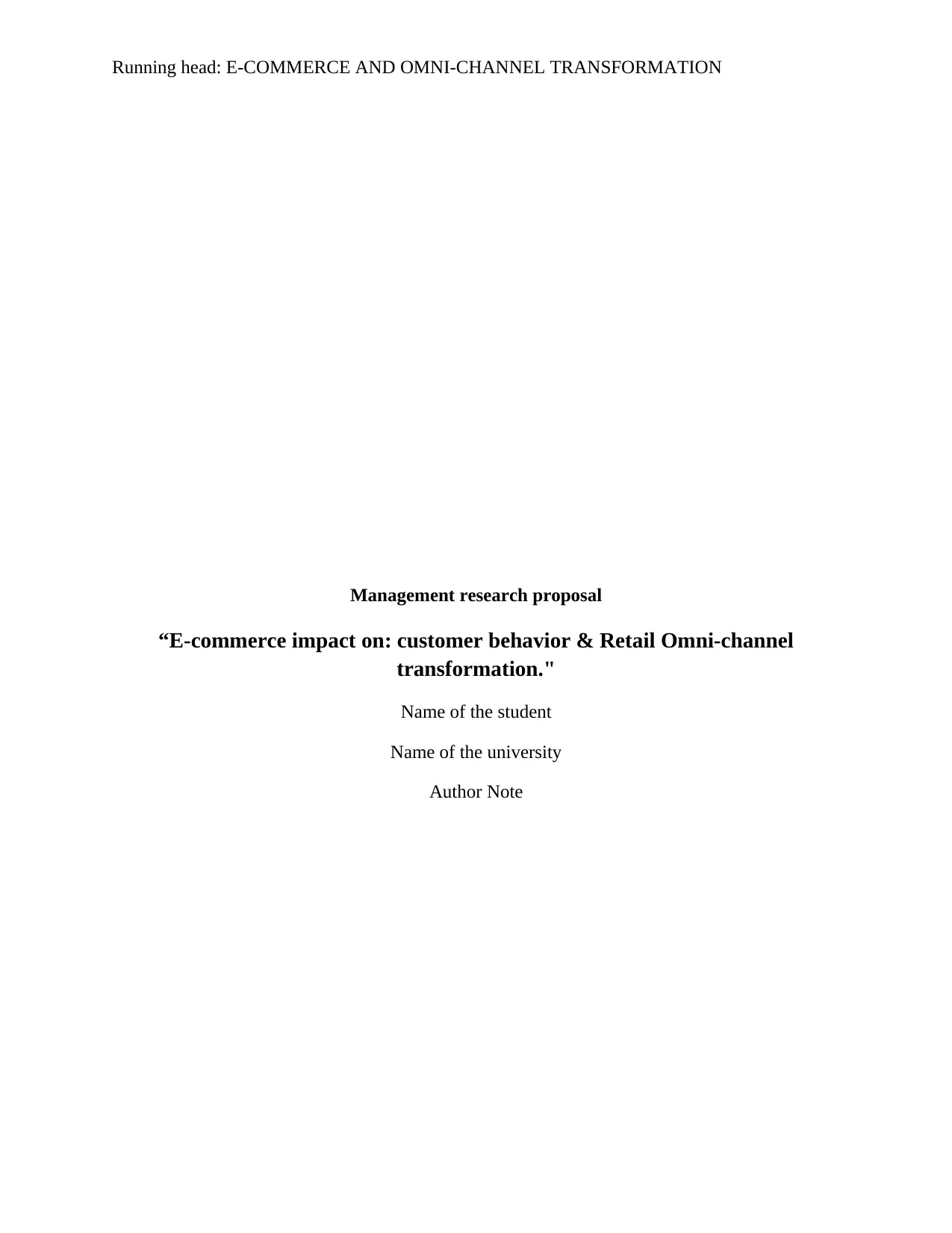
Running head: E-COMMERCE AND OMNI-CHANNEL TRANSFORMATION
Management research proposal
“E-commerce impact on: customer behavior & Retail Omni-channel
transformation."
Name of the student
Name of the university
Author Note
Management research proposal
“E-commerce impact on: customer behavior & Retail Omni-channel
transformation."
Name of the student
Name of the university
Author Note
Paraphrase This Document
Need a fresh take? Get an instant paraphrase of this document with our AI Paraphraser
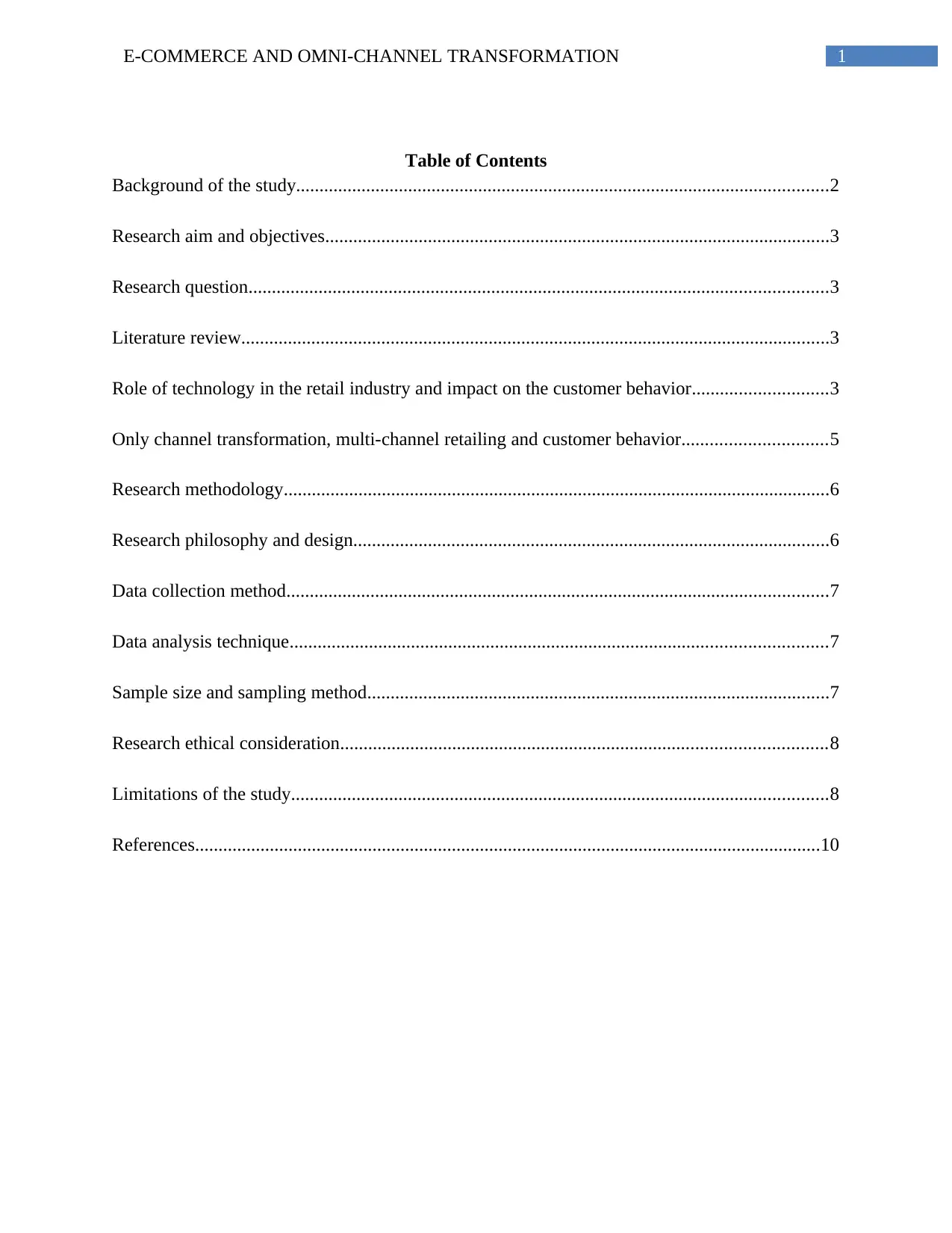
1E-COMMERCE AND OMNI-CHANNEL TRANSFORMATION
Table of Contents
Background of the study..................................................................................................................2
Research aim and objectives............................................................................................................3
Research question............................................................................................................................3
Literature review..............................................................................................................................3
Role of technology in the retail industry and impact on the customer behavior.............................3
Only channel transformation, multi-channel retailing and customer behavior...............................5
Research methodology.....................................................................................................................6
Research philosophy and design......................................................................................................6
Data collection method....................................................................................................................7
Data analysis technique...................................................................................................................7
Sample size and sampling method...................................................................................................7
Research ethical consideration........................................................................................................8
Limitations of the study...................................................................................................................8
References......................................................................................................................................10
Table of Contents
Background of the study..................................................................................................................2
Research aim and objectives............................................................................................................3
Research question............................................................................................................................3
Literature review..............................................................................................................................3
Role of technology in the retail industry and impact on the customer behavior.............................3
Only channel transformation, multi-channel retailing and customer behavior...............................5
Research methodology.....................................................................................................................6
Research philosophy and design......................................................................................................6
Data collection method....................................................................................................................7
Data analysis technique...................................................................................................................7
Sample size and sampling method...................................................................................................7
Research ethical consideration........................................................................................................8
Limitations of the study...................................................................................................................8
References......................................................................................................................................10
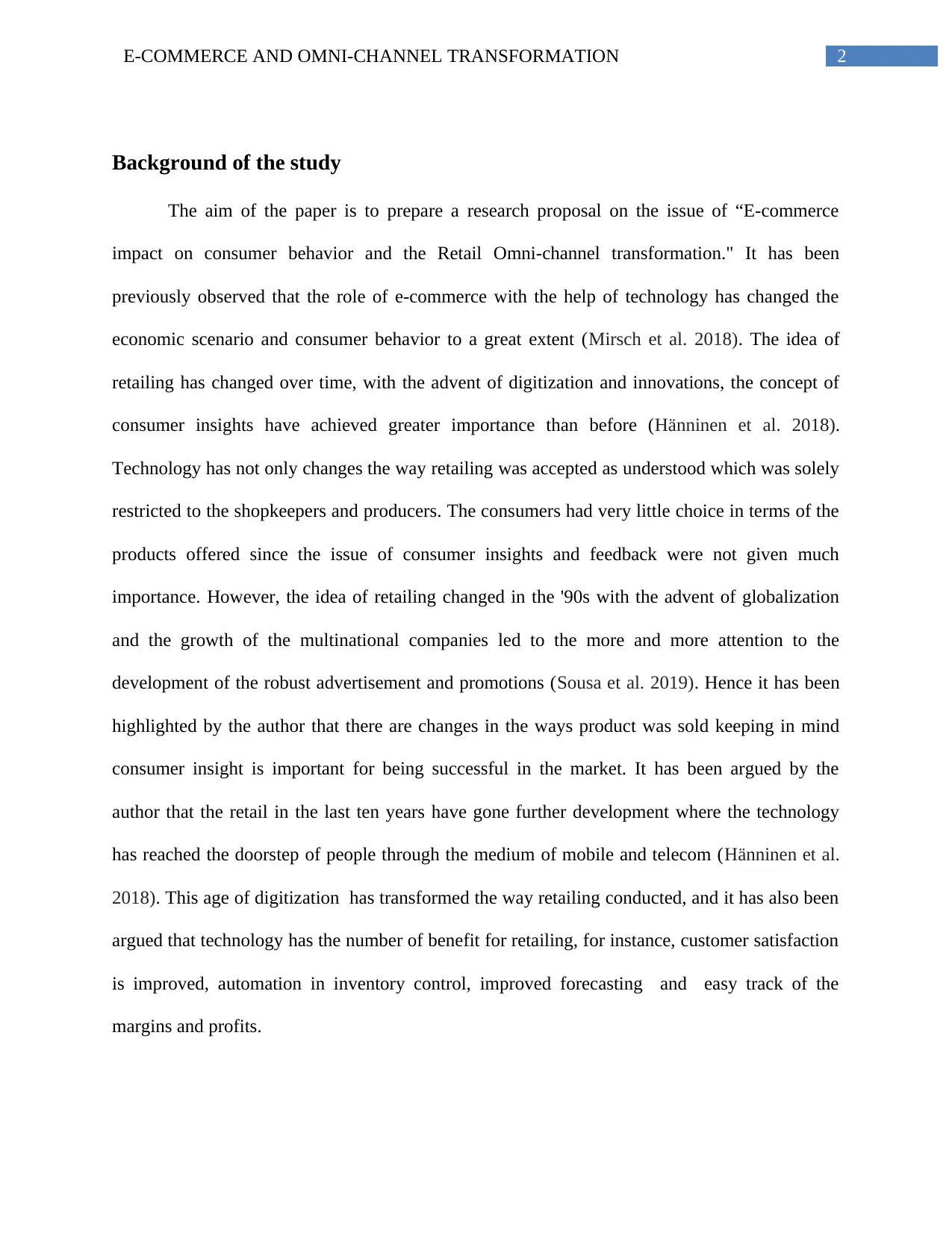
2E-COMMERCE AND OMNI-CHANNEL TRANSFORMATION
Background of the study
The aim of the paper is to prepare a research proposal on the issue of “E-commerce
impact on consumer behavior and the Retail Omni-channel transformation." It has been
previously observed that the role of e-commerce with the help of technology has changed the
economic scenario and consumer behavior to a great extent (Mirsch et al. 2018). The idea of
retailing has changed over time, with the advent of digitization and innovations, the concept of
consumer insights have achieved greater importance than before (Hänninen et al. 2018).
Technology has not only changes the way retailing was accepted as understood which was solely
restricted to the shopkeepers and producers. The consumers had very little choice in terms of the
products offered since the issue of consumer insights and feedback were not given much
importance. However, the idea of retailing changed in the '90s with the advent of globalization
and the growth of the multinational companies led to the more and more attention to the
development of the robust advertisement and promotions (Sousa et al. 2019). Hence it has been
highlighted by the author that there are changes in the ways product was sold keeping in mind
consumer insight is important for being successful in the market. It has been argued by the
author that the retail in the last ten years have gone further development where the technology
has reached the doorstep of people through the medium of mobile and telecom (Hänninen et al.
2018). This age of digitization has transformed the way retailing conducted, and it has also been
argued that technology has the number of benefit for retailing, for instance, customer satisfaction
is improved, automation in inventory control, improved forecasting and easy track of the
margins and profits.
Background of the study
The aim of the paper is to prepare a research proposal on the issue of “E-commerce
impact on consumer behavior and the Retail Omni-channel transformation." It has been
previously observed that the role of e-commerce with the help of technology has changed the
economic scenario and consumer behavior to a great extent (Mirsch et al. 2018). The idea of
retailing has changed over time, with the advent of digitization and innovations, the concept of
consumer insights have achieved greater importance than before (Hänninen et al. 2018).
Technology has not only changes the way retailing was accepted as understood which was solely
restricted to the shopkeepers and producers. The consumers had very little choice in terms of the
products offered since the issue of consumer insights and feedback were not given much
importance. However, the idea of retailing changed in the '90s with the advent of globalization
and the growth of the multinational companies led to the more and more attention to the
development of the robust advertisement and promotions (Sousa et al. 2019). Hence it has been
highlighted by the author that there are changes in the ways product was sold keeping in mind
consumer insight is important for being successful in the market. It has been argued by the
author that the retail in the last ten years have gone further development where the technology
has reached the doorstep of people through the medium of mobile and telecom (Hänninen et al.
2018). This age of digitization has transformed the way retailing conducted, and it has also been
argued that technology has the number of benefit for retailing, for instance, customer satisfaction
is improved, automation in inventory control, improved forecasting and easy track of the
margins and profits.
⊘ This is a preview!⊘
Do you want full access?
Subscribe today to unlock all pages.

Trusted by 1+ million students worldwide
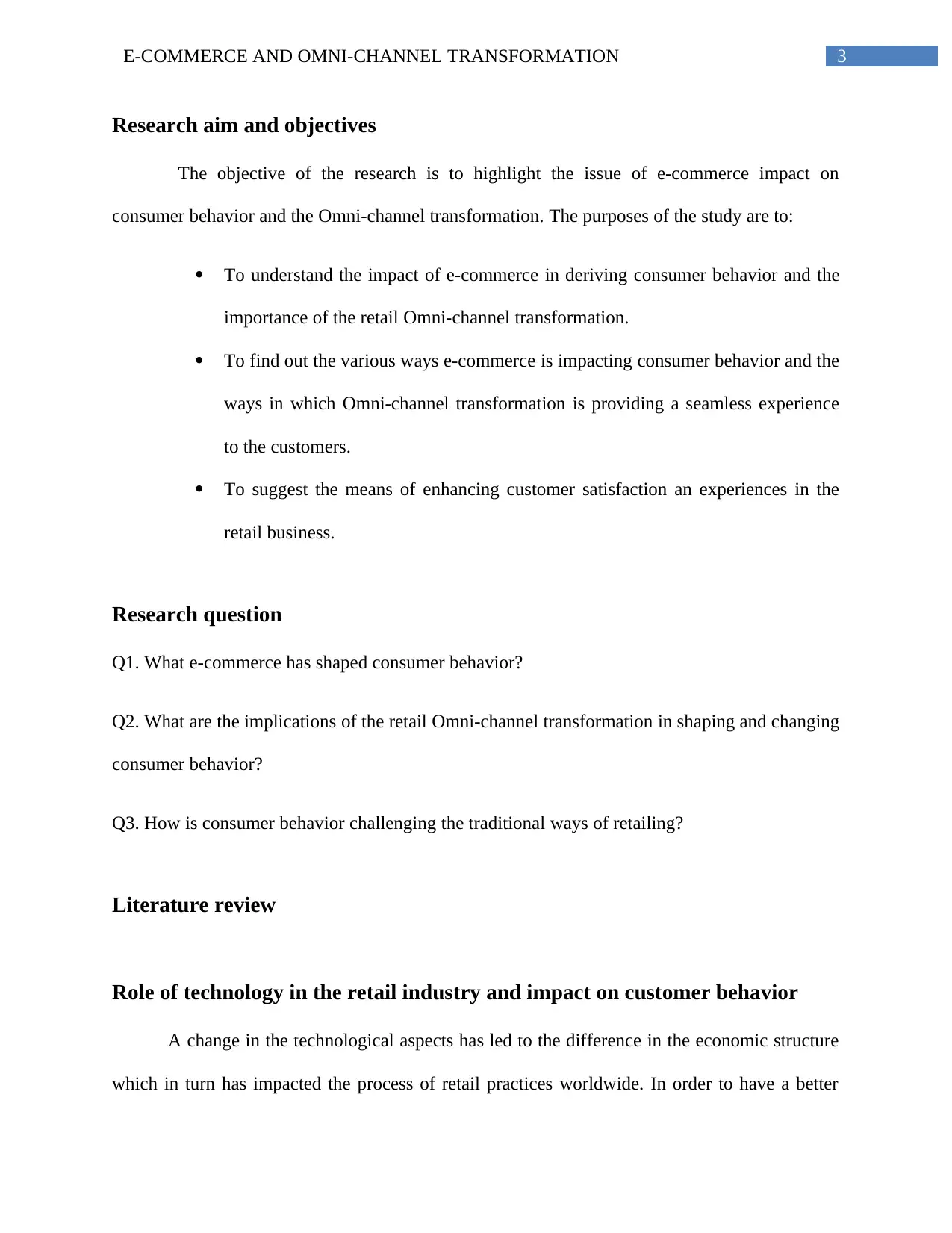
3E-COMMERCE AND OMNI-CHANNEL TRANSFORMATION
Research aim and objectives
The objective of the research is to highlight the issue of e-commerce impact on
consumer behavior and the Omni-channel transformation. The purposes of the study are to:
To understand the impact of e-commerce in deriving consumer behavior and the
importance of the retail Omni-channel transformation.
To find out the various ways e-commerce is impacting consumer behavior and the
ways in which Omni-channel transformation is providing a seamless experience
to the customers.
To suggest the means of enhancing customer satisfaction an experiences in the
retail business.
Research question
Q1. What e-commerce has shaped consumer behavior?
Q2. What are the implications of the retail Omni-channel transformation in shaping and changing
consumer behavior?
Q3. How is consumer behavior challenging the traditional ways of retailing?
Literature review
Role of technology in the retail industry and impact on customer behavior
A change in the technological aspects has led to the difference in the economic structure
which in turn has impacted the process of retail practices worldwide. In order to have a better
Research aim and objectives
The objective of the research is to highlight the issue of e-commerce impact on
consumer behavior and the Omni-channel transformation. The purposes of the study are to:
To understand the impact of e-commerce in deriving consumer behavior and the
importance of the retail Omni-channel transformation.
To find out the various ways e-commerce is impacting consumer behavior and the
ways in which Omni-channel transformation is providing a seamless experience
to the customers.
To suggest the means of enhancing customer satisfaction an experiences in the
retail business.
Research question
Q1. What e-commerce has shaped consumer behavior?
Q2. What are the implications of the retail Omni-channel transformation in shaping and changing
consumer behavior?
Q3. How is consumer behavior challenging the traditional ways of retailing?
Literature review
Role of technology in the retail industry and impact on customer behavior
A change in the technological aspects has led to the difference in the economic structure
which in turn has impacted the process of retail practices worldwide. In order to have a better
Paraphrase This Document
Need a fresh take? Get an instant paraphrase of this document with our AI Paraphraser
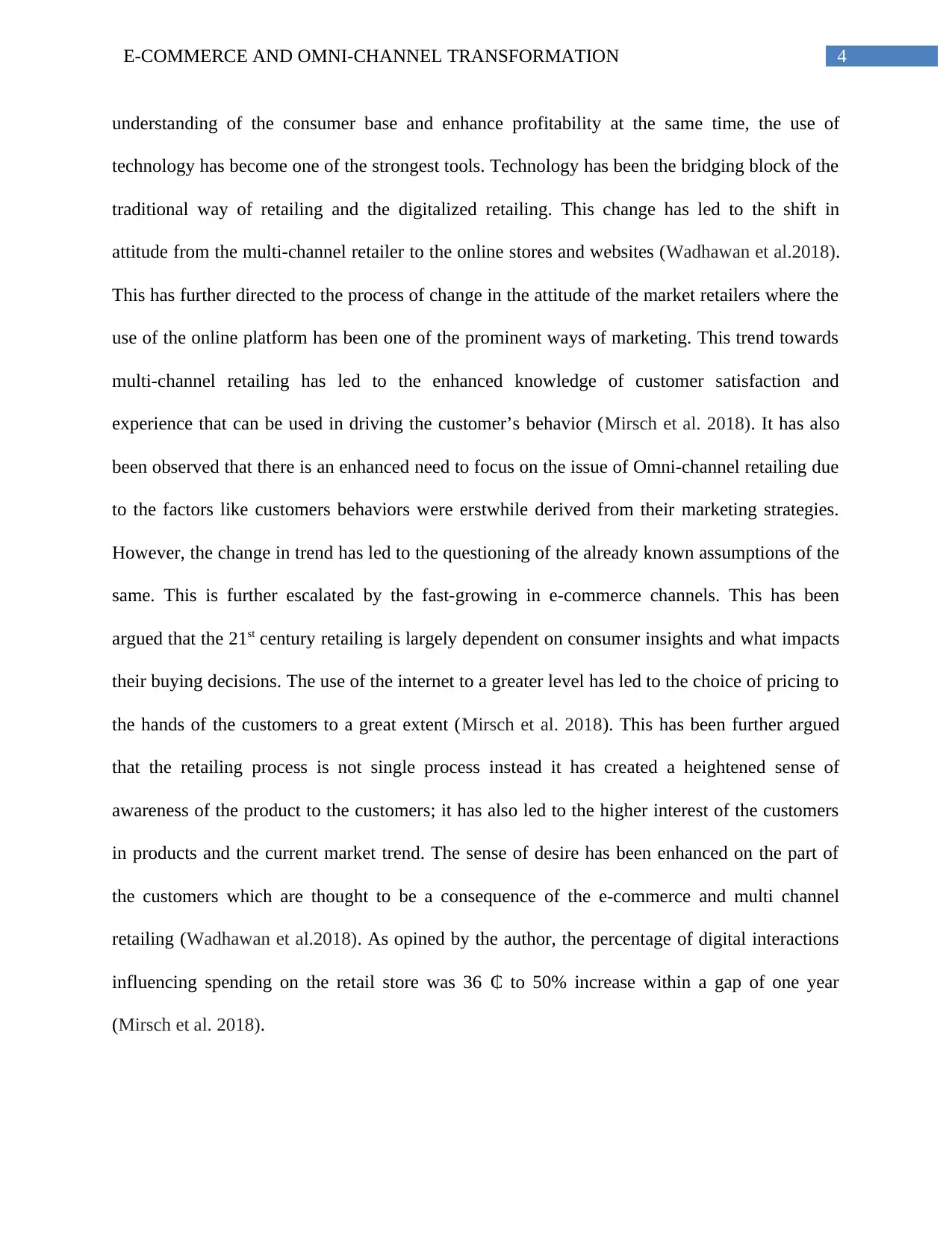
4E-COMMERCE AND OMNI-CHANNEL TRANSFORMATION
understanding of the consumer base and enhance profitability at the same time, the use of
technology has become one of the strongest tools. Technology has been the bridging block of the
traditional way of retailing and the digitalized retailing. This change has led to the shift in
attitude from the multi-channel retailer to the online stores and websites (Wadhawan et al.2018).
This has further directed to the process of change in the attitude of the market retailers where the
use of the online platform has been one of the prominent ways of marketing. This trend towards
multi-channel retailing has led to the enhanced knowledge of customer satisfaction and
experience that can be used in driving the customer’s behavior (Mirsch et al. 2018). It has also
been observed that there is an enhanced need to focus on the issue of Omni-channel retailing due
to the factors like customers behaviors were erstwhile derived from their marketing strategies.
However, the change in trend has led to the questioning of the already known assumptions of the
same. This is further escalated by the fast-growing in e-commerce channels. This has been
argued that the 21st century retailing is largely dependent on consumer insights and what impacts
their buying decisions. The use of the internet to a greater level has led to the choice of pricing to
the hands of the customers to a great extent (Mirsch et al. 2018). This has been further argued
that the retailing process is not single process instead it has created a heightened sense of
awareness of the product to the customers; it has also led to the higher interest of the customers
in products and the current market trend. The sense of desire has been enhanced on the part of
the customers which are thought to be a consequence of the e-commerce and multi channel
retailing (Wadhawan et al.2018). As opined by the author, the percentage of digital interactions
influencing spending on the retail store was 36 ₵ to 50% increase within a gap of one year
(Mirsch et al. 2018).
understanding of the consumer base and enhance profitability at the same time, the use of
technology has become one of the strongest tools. Technology has been the bridging block of the
traditional way of retailing and the digitalized retailing. This change has led to the shift in
attitude from the multi-channel retailer to the online stores and websites (Wadhawan et al.2018).
This has further directed to the process of change in the attitude of the market retailers where the
use of the online platform has been one of the prominent ways of marketing. This trend towards
multi-channel retailing has led to the enhanced knowledge of customer satisfaction and
experience that can be used in driving the customer’s behavior (Mirsch et al. 2018). It has also
been observed that there is an enhanced need to focus on the issue of Omni-channel retailing due
to the factors like customers behaviors were erstwhile derived from their marketing strategies.
However, the change in trend has led to the questioning of the already known assumptions of the
same. This is further escalated by the fast-growing in e-commerce channels. This has been
argued that the 21st century retailing is largely dependent on consumer insights and what impacts
their buying decisions. The use of the internet to a greater level has led to the choice of pricing to
the hands of the customers to a great extent (Mirsch et al. 2018). This has been further argued
that the retailing process is not single process instead it has created a heightened sense of
awareness of the product to the customers; it has also led to the higher interest of the customers
in products and the current market trend. The sense of desire has been enhanced on the part of
the customers which are thought to be a consequence of the e-commerce and multi channel
retailing (Wadhawan et al.2018). As opined by the author, the percentage of digital interactions
influencing spending on the retail store was 36 ₵ to 50% increase within a gap of one year
(Mirsch et al. 2018).
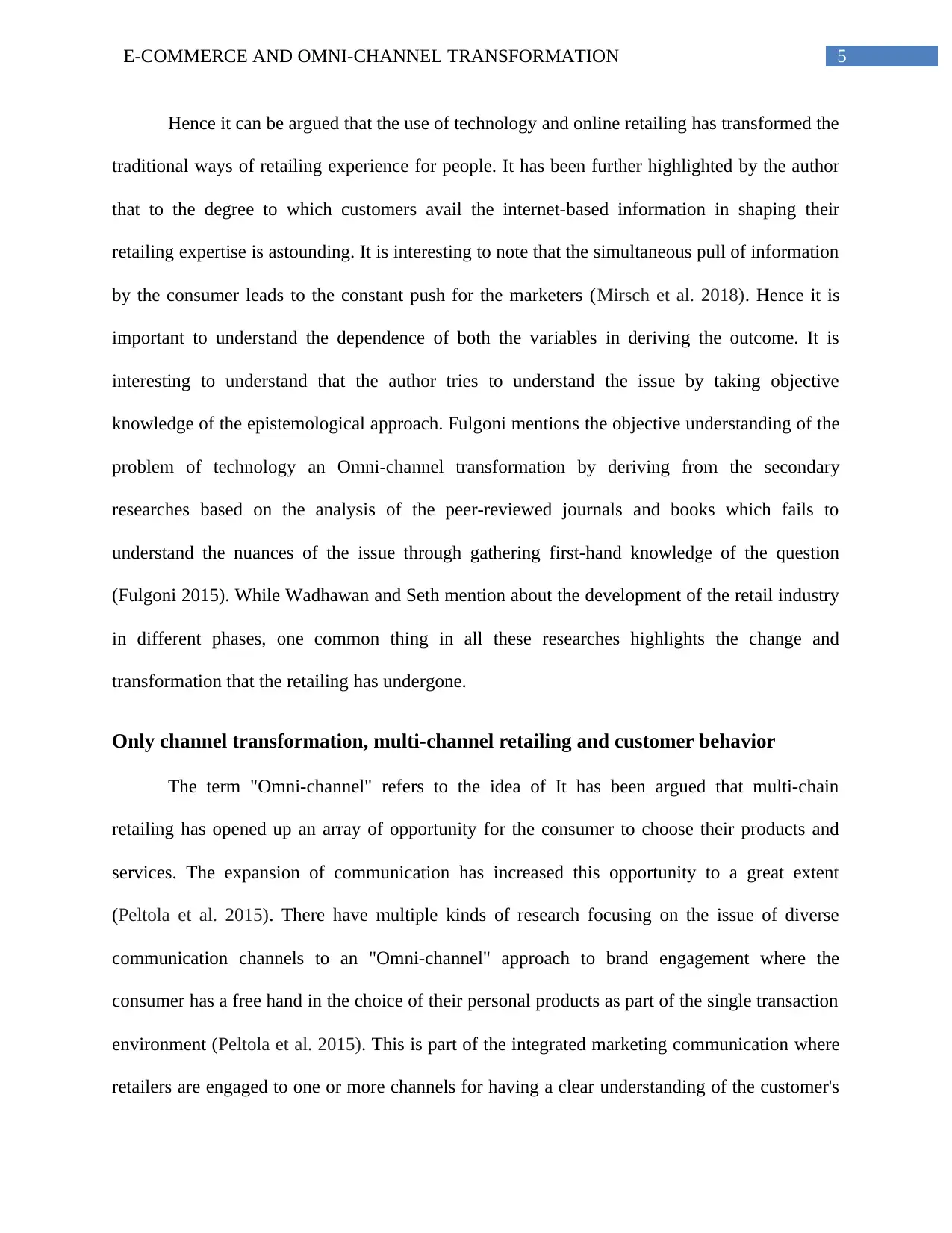
5E-COMMERCE AND OMNI-CHANNEL TRANSFORMATION
Hence it can be argued that the use of technology and online retailing has transformed the
traditional ways of retailing experience for people. It has been further highlighted by the author
that to the degree to which customers avail the internet-based information in shaping their
retailing expertise is astounding. It is interesting to note that the simultaneous pull of information
by the consumer leads to the constant push for the marketers (Mirsch et al. 2018). Hence it is
important to understand the dependence of both the variables in deriving the outcome. It is
interesting to understand that the author tries to understand the issue by taking objective
knowledge of the epistemological approach. Fulgoni mentions the objective understanding of the
problem of technology an Omni-channel transformation by deriving from the secondary
researches based on the analysis of the peer-reviewed journals and books which fails to
understand the nuances of the issue through gathering first-hand knowledge of the question
(Fulgoni 2015). While Wadhawan and Seth mention about the development of the retail industry
in different phases, one common thing in all these researches highlights the change and
transformation that the retailing has undergone.
Only channel transformation, multi-channel retailing and customer behavior
The term "Omni-channel" refers to the idea of It has been argued that multi-chain
retailing has opened up an array of opportunity for the consumer to choose their products and
services. The expansion of communication has increased this opportunity to a great extent
(Peltola et al. 2015). There have multiple kinds of research focusing on the issue of diverse
communication channels to an "Omni-channel" approach to brand engagement where the
consumer has a free hand in the choice of their personal products as part of the single transaction
environment (Peltola et al. 2015). This is part of the integrated marketing communication where
retailers are engaged to one or more channels for having a clear understanding of the customer's
Hence it can be argued that the use of technology and online retailing has transformed the
traditional ways of retailing experience for people. It has been further highlighted by the author
that to the degree to which customers avail the internet-based information in shaping their
retailing expertise is astounding. It is interesting to note that the simultaneous pull of information
by the consumer leads to the constant push for the marketers (Mirsch et al. 2018). Hence it is
important to understand the dependence of both the variables in deriving the outcome. It is
interesting to understand that the author tries to understand the issue by taking objective
knowledge of the epistemological approach. Fulgoni mentions the objective understanding of the
problem of technology an Omni-channel transformation by deriving from the secondary
researches based on the analysis of the peer-reviewed journals and books which fails to
understand the nuances of the issue through gathering first-hand knowledge of the question
(Fulgoni 2015). While Wadhawan and Seth mention about the development of the retail industry
in different phases, one common thing in all these researches highlights the change and
transformation that the retailing has undergone.
Only channel transformation, multi-channel retailing and customer behavior
The term "Omni-channel" refers to the idea of It has been argued that multi-chain
retailing has opened up an array of opportunity for the consumer to choose their products and
services. The expansion of communication has increased this opportunity to a great extent
(Peltola et al. 2015). There have multiple kinds of research focusing on the issue of diverse
communication channels to an "Omni-channel" approach to brand engagement where the
consumer has a free hand in the choice of their personal products as part of the single transaction
environment (Peltola et al. 2015). This is part of the integrated marketing communication where
retailers are engaged to one or more channels for having a clear understanding of the customer's
⊘ This is a preview!⊘
Do you want full access?
Subscribe today to unlock all pages.

Trusted by 1+ million students worldwide
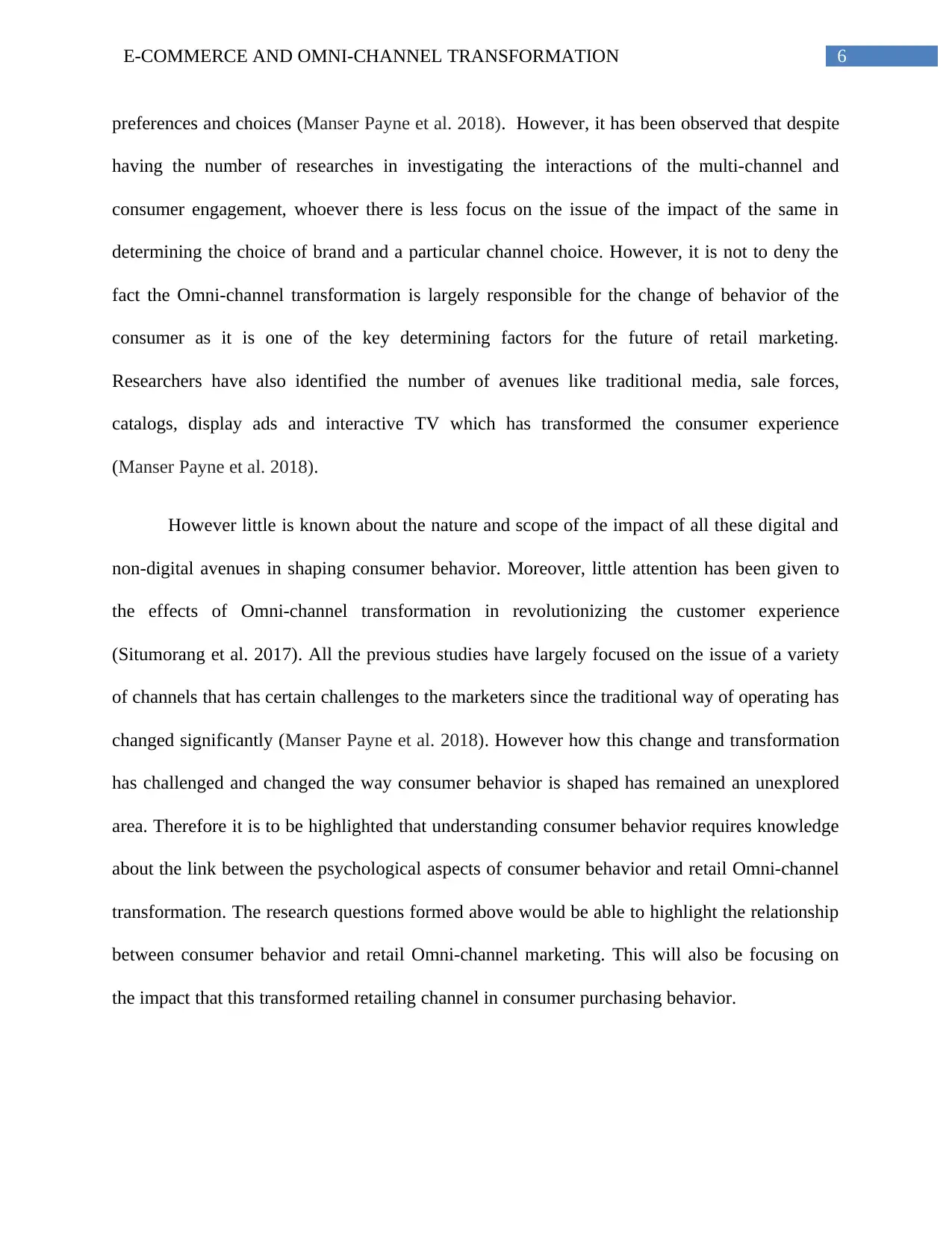
6E-COMMERCE AND OMNI-CHANNEL TRANSFORMATION
preferences and choices (Manser Payne et al. 2018). However, it has been observed that despite
having the number of researches in investigating the interactions of the multi-channel and
consumer engagement, whoever there is less focus on the issue of the impact of the same in
determining the choice of brand and a particular channel choice. However, it is not to deny the
fact the Omni-channel transformation is largely responsible for the change of behavior of the
consumer as it is one of the key determining factors for the future of retail marketing.
Researchers have also identified the number of avenues like traditional media, sale forces,
catalogs, display ads and interactive TV which has transformed the consumer experience
(Manser Payne et al. 2018).
However little is known about the nature and scope of the impact of all these digital and
non-digital avenues in shaping consumer behavior. Moreover, little attention has been given to
the effects of Omni-channel transformation in revolutionizing the customer experience
(Situmorang et al. 2017). All the previous studies have largely focused on the issue of a variety
of channels that has certain challenges to the marketers since the traditional way of operating has
changed significantly (Manser Payne et al. 2018). However how this change and transformation
has challenged and changed the way consumer behavior is shaped has remained an unexplored
area. Therefore it is to be highlighted that understanding consumer behavior requires knowledge
about the link between the psychological aspects of consumer behavior and retail Omni-channel
transformation. The research questions formed above would be able to highlight the relationship
between consumer behavior and retail Omni-channel marketing. This will also be focusing on
the impact that this transformed retailing channel in consumer purchasing behavior.
preferences and choices (Manser Payne et al. 2018). However, it has been observed that despite
having the number of researches in investigating the interactions of the multi-channel and
consumer engagement, whoever there is less focus on the issue of the impact of the same in
determining the choice of brand and a particular channel choice. However, it is not to deny the
fact the Omni-channel transformation is largely responsible for the change of behavior of the
consumer as it is one of the key determining factors for the future of retail marketing.
Researchers have also identified the number of avenues like traditional media, sale forces,
catalogs, display ads and interactive TV which has transformed the consumer experience
(Manser Payne et al. 2018).
However little is known about the nature and scope of the impact of all these digital and
non-digital avenues in shaping consumer behavior. Moreover, little attention has been given to
the effects of Omni-channel transformation in revolutionizing the customer experience
(Situmorang et al. 2017). All the previous studies have largely focused on the issue of a variety
of channels that has certain challenges to the marketers since the traditional way of operating has
changed significantly (Manser Payne et al. 2018). However how this change and transformation
has challenged and changed the way consumer behavior is shaped has remained an unexplored
area. Therefore it is to be highlighted that understanding consumer behavior requires knowledge
about the link between the psychological aspects of consumer behavior and retail Omni-channel
transformation. The research questions formed above would be able to highlight the relationship
between consumer behavior and retail Omni-channel marketing. This will also be focusing on
the impact that this transformed retailing channel in consumer purchasing behavior.
Paraphrase This Document
Need a fresh take? Get an instant paraphrase of this document with our AI Paraphraser
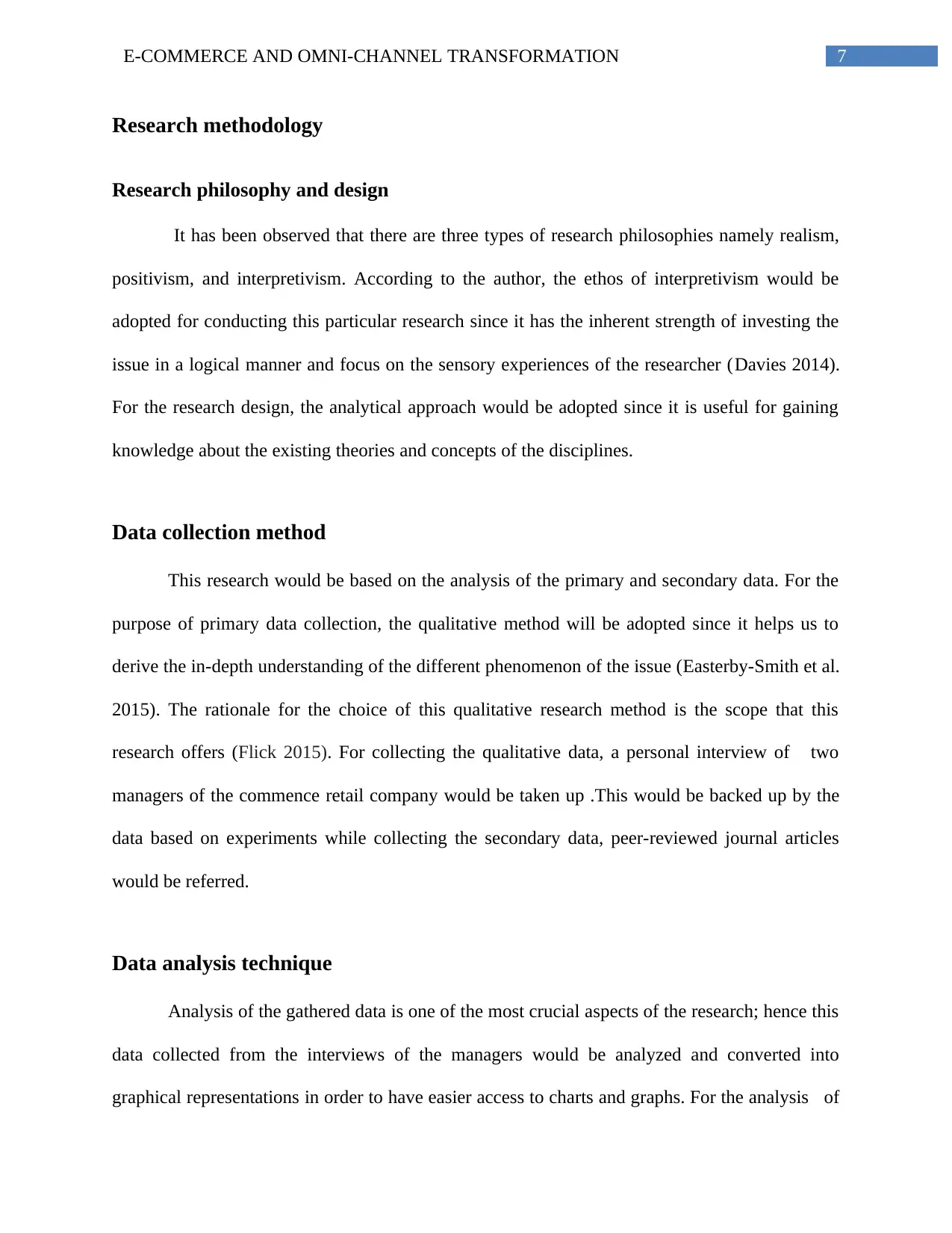
7E-COMMERCE AND OMNI-CHANNEL TRANSFORMATION
Research methodology
Research philosophy and design
It has been observed that there are three types of research philosophies namely realism,
positivism, and interpretivism. According to the author, the ethos of interpretivism would be
adopted for conducting this particular research since it has the inherent strength of investing the
issue in a logical manner and focus on the sensory experiences of the researcher (Davies 2014).
For the research design, the analytical approach would be adopted since it is useful for gaining
knowledge about the existing theories and concepts of the disciplines.
Data collection method
This research would be based on the analysis of the primary and secondary data. For the
purpose of primary data collection, the qualitative method will be adopted since it helps us to
derive the in-depth understanding of the different phenomenon of the issue (Easterby-Smith et al.
2015). The rationale for the choice of this qualitative research method is the scope that this
research offers (Flick 2015). For collecting the qualitative data, a personal interview of two
managers of the commence retail company would be taken up .This would be backed up by the
data based on experiments while collecting the secondary data, peer-reviewed journal articles
would be referred.
Data analysis technique
Analysis of the gathered data is one of the most crucial aspects of the research; hence this
data collected from the interviews of the managers would be analyzed and converted into
graphical representations in order to have easier access to charts and graphs. For the analysis of
Research methodology
Research philosophy and design
It has been observed that there are three types of research philosophies namely realism,
positivism, and interpretivism. According to the author, the ethos of interpretivism would be
adopted for conducting this particular research since it has the inherent strength of investing the
issue in a logical manner and focus on the sensory experiences of the researcher (Davies 2014).
For the research design, the analytical approach would be adopted since it is useful for gaining
knowledge about the existing theories and concepts of the disciplines.
Data collection method
This research would be based on the analysis of the primary and secondary data. For the
purpose of primary data collection, the qualitative method will be adopted since it helps us to
derive the in-depth understanding of the different phenomenon of the issue (Easterby-Smith et al.
2015). The rationale for the choice of this qualitative research method is the scope that this
research offers (Flick 2015). For collecting the qualitative data, a personal interview of two
managers of the commence retail company would be taken up .This would be backed up by the
data based on experiments while collecting the secondary data, peer-reviewed journal articles
would be referred.
Data analysis technique
Analysis of the gathered data is one of the most crucial aspects of the research; hence this
data collected from the interviews of the managers would be analyzed and converted into
graphical representations in order to have easier access to charts and graphs. For the analysis of
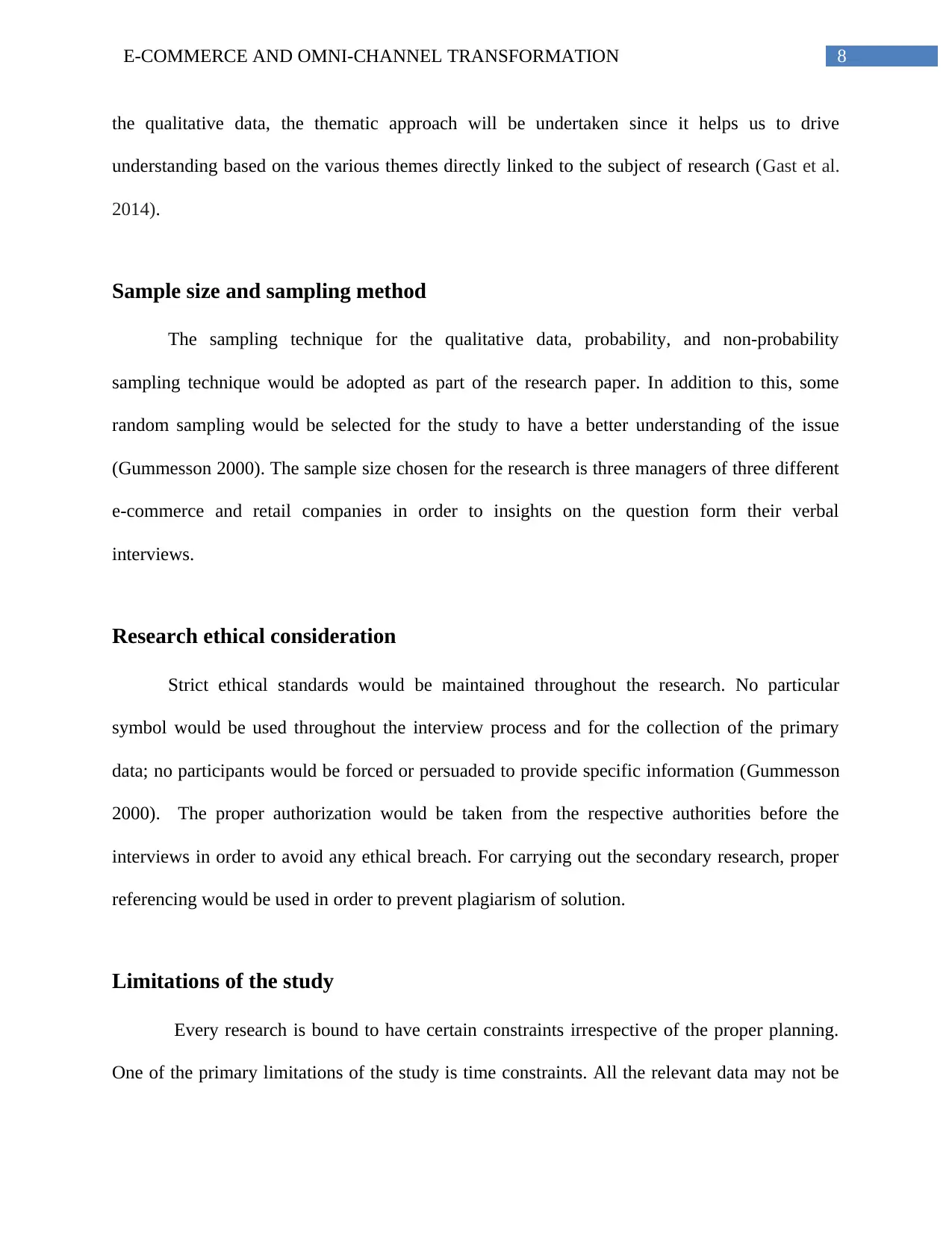
8E-COMMERCE AND OMNI-CHANNEL TRANSFORMATION
the qualitative data, the thematic approach will be undertaken since it helps us to drive
understanding based on the various themes directly linked to the subject of research (Gast et al.
2014).
Sample size and sampling method
The sampling technique for the qualitative data, probability, and non-probability
sampling technique would be adopted as part of the research paper. In addition to this, some
random sampling would be selected for the study to have a better understanding of the issue
(Gummesson 2000). The sample size chosen for the research is three managers of three different
e-commerce and retail companies in order to insights on the question form their verbal
interviews.
Research ethical consideration
Strict ethical standards would be maintained throughout the research. No particular
symbol would be used throughout the interview process and for the collection of the primary
data; no participants would be forced or persuaded to provide specific information (Gummesson
2000). The proper authorization would be taken from the respective authorities before the
interviews in order to avoid any ethical breach. For carrying out the secondary research, proper
referencing would be used in order to prevent plagiarism of solution.
Limitations of the study
Every research is bound to have certain constraints irrespective of the proper planning.
One of the primary limitations of the study is time constraints. All the relevant data may not be
the qualitative data, the thematic approach will be undertaken since it helps us to drive
understanding based on the various themes directly linked to the subject of research (Gast et al.
2014).
Sample size and sampling method
The sampling technique for the qualitative data, probability, and non-probability
sampling technique would be adopted as part of the research paper. In addition to this, some
random sampling would be selected for the study to have a better understanding of the issue
(Gummesson 2000). The sample size chosen for the research is three managers of three different
e-commerce and retail companies in order to insights on the question form their verbal
interviews.
Research ethical consideration
Strict ethical standards would be maintained throughout the research. No particular
symbol would be used throughout the interview process and for the collection of the primary
data; no participants would be forced or persuaded to provide specific information (Gummesson
2000). The proper authorization would be taken from the respective authorities before the
interviews in order to avoid any ethical breach. For carrying out the secondary research, proper
referencing would be used in order to prevent plagiarism of solution.
Limitations of the study
Every research is bound to have certain constraints irrespective of the proper planning.
One of the primary limitations of the study is time constraints. All the relevant data may not be
⊘ This is a preview!⊘
Do you want full access?
Subscribe today to unlock all pages.

Trusted by 1+ million students worldwide

9E-COMMERCE AND OMNI-CHANNEL TRANSFORMATION
available which might restrict the scope of the research. In addition to this limitation, all
secondary resources may not be available for the study and available data may not be enough for
deriving the required knowledge. Lastly, it might be difficult to gain permission from the
managers and adjust the interview dates.
available which might restrict the scope of the research. In addition to this limitation, all
secondary resources may not be available for the study and available data may not be enough for
deriving the required knowledge. Lastly, it might be difficult to gain permission from the
managers and adjust the interview dates.
Paraphrase This Document
Need a fresh take? Get an instant paraphrase of this document with our AI Paraphraser
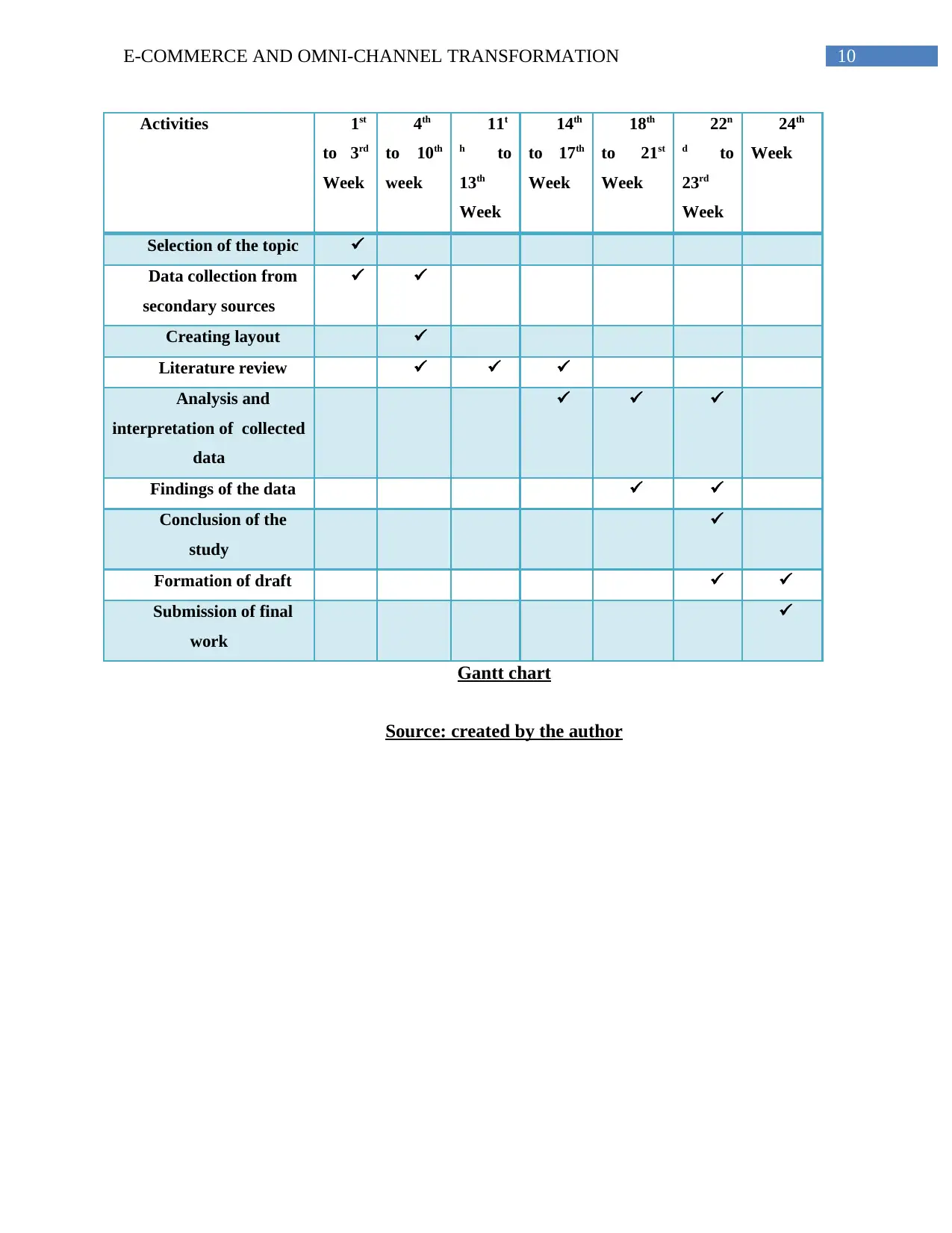
10E-COMMERCE AND OMNI-CHANNEL TRANSFORMATION
Activities 1st
to 3rd
Week
4th
to 10th
week
11t
h to
13th
Week
14th
to 17th
Week
18th
to 21st
Week
22n
d to
23rd
Week
24th
Week
Selection of the topic
Data collection from
secondary sources
Creating layout
Literature review
Analysis and
interpretation of collected
data
Findings of the data
Conclusion of the
study
Formation of draft
Submission of final
work
Gantt chart
Source: created by the author
Activities 1st
to 3rd
Week
4th
to 10th
week
11t
h to
13th
Week
14th
to 17th
Week
18th
to 21st
Week
22n
d to
23rd
Week
24th
Week
Selection of the topic
Data collection from
secondary sources
Creating layout
Literature review
Analysis and
interpretation of collected
data
Findings of the data
Conclusion of the
study
Formation of draft
Submission of final
work
Gantt chart
Source: created by the author
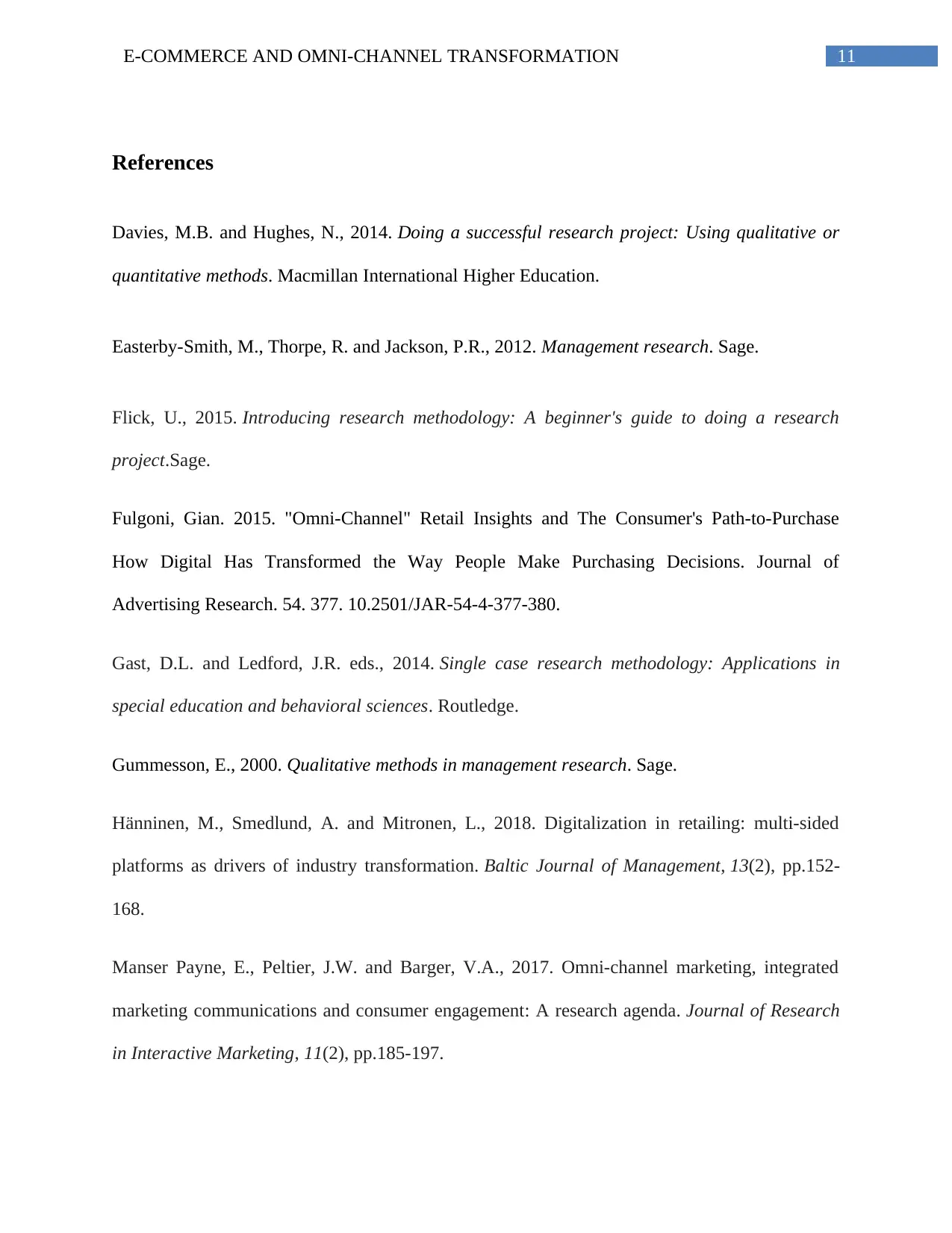
11E-COMMERCE AND OMNI-CHANNEL TRANSFORMATION
References
Davies, M.B. and Hughes, N., 2014. Doing a successful research project: Using qualitative or
quantitative methods. Macmillan International Higher Education.
Easterby-Smith, M., Thorpe, R. and Jackson, P.R., 2012. Management research. Sage.
Flick, U., 2015. Introducing research methodology: A beginner's guide to doing a research
project.Sage.
Fulgoni, Gian. 2015. "Omni-Channel" Retail Insights and The Consumer's Path-to-Purchase
How Digital Has Transformed the Way People Make Purchasing Decisions. Journal of
Advertising Research. 54. 377. 10.2501/JAR-54-4-377-380.
Gast, D.L. and Ledford, J.R. eds., 2014. Single case research methodology: Applications in
special education and behavioral sciences. Routledge.
Gummesson, E., 2000. Qualitative methods in management research. Sage.
Hänninen, M., Smedlund, A. and Mitronen, L., 2018. Digitalization in retailing: multi-sided
platforms as drivers of industry transformation. Baltic Journal of Management, 13(2), pp.152-
168.
Manser Payne, E., Peltier, J.W. and Barger, V.A., 2017. Omni-channel marketing, integrated
marketing communications and consumer engagement: A research agenda. Journal of Research
in Interactive Marketing, 11(2), pp.185-197.
References
Davies, M.B. and Hughes, N., 2014. Doing a successful research project: Using qualitative or
quantitative methods. Macmillan International Higher Education.
Easterby-Smith, M., Thorpe, R. and Jackson, P.R., 2012. Management research. Sage.
Flick, U., 2015. Introducing research methodology: A beginner's guide to doing a research
project.Sage.
Fulgoni, Gian. 2015. "Omni-Channel" Retail Insights and The Consumer's Path-to-Purchase
How Digital Has Transformed the Way People Make Purchasing Decisions. Journal of
Advertising Research. 54. 377. 10.2501/JAR-54-4-377-380.
Gast, D.L. and Ledford, J.R. eds., 2014. Single case research methodology: Applications in
special education and behavioral sciences. Routledge.
Gummesson, E., 2000. Qualitative methods in management research. Sage.
Hänninen, M., Smedlund, A. and Mitronen, L., 2018. Digitalization in retailing: multi-sided
platforms as drivers of industry transformation. Baltic Journal of Management, 13(2), pp.152-
168.
Manser Payne, E., Peltier, J.W. and Barger, V.A., 2017. Omni-channel marketing, integrated
marketing communications and consumer engagement: A research agenda. Journal of Research
in Interactive Marketing, 11(2), pp.185-197.
⊘ This is a preview!⊘
Do you want full access?
Subscribe today to unlock all pages.

Trusted by 1+ million students worldwide
1 out of 13
Related Documents
Your All-in-One AI-Powered Toolkit for Academic Success.
+13062052269
info@desklib.com
Available 24*7 on WhatsApp / Email
![[object Object]](/_next/static/media/star-bottom.7253800d.svg)
Unlock your academic potential
Copyright © 2020–2025 A2Z Services. All Rights Reserved. Developed and managed by ZUCOL.




